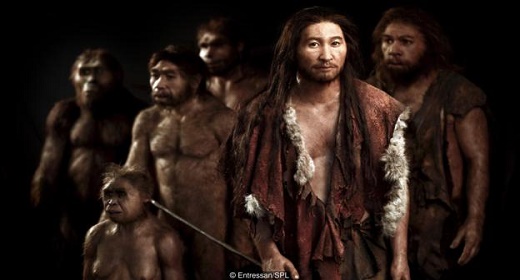by Melissa Hogenboom: Clothes are not a necessity for everyone, so why do we bother wearing clothes at all?

Stephen Gough likes to be naked; so much so, it has cost him his freedom. He has spent a combined total of 10 years in prison for showing too much skin in public, having been arrested multiple times.
Gough, also known as the “naked rambler”, prefers to get naked when temperatures warm up. He is not a danger to the public, but when he walked naked from John o’Groats to Lands’ End in the UK in 2003, he caused outcries around the country.
Some hunter-gatherer societies still choose to live mostly naked
When he attempted the journey again he was quickly arrested. In prison he was often put into solitary confinement for his refusal to wear clothes.
And yet, nobody can argue with the fact that we are all born, like Gough, without clothes. The difference is that most of us go on to cover up in our public lives.
There are good reasons to do so: in colder climes we would freeze to death without some extra padding, and in intense heat clothing can also shield us from the Sun. However, some hunter-gatherer societies still choose to live mostly naked, which suggests that clothing is not vital for our survival.
So if being naked is so natural, when did our obsession with clothing begin, and why?
Clothes do not fossilise, so we cannot get direct evidence for the time when our early human – “hominin” – ancestors stopped wandering about naked, and started draping their bodies with animal furs and skins.
Instead, anthropologists largely rely on indirect methods to date the origin of clothes. A 2011 study on lice suggested that it was only 170,000 years ago when it all began. Researchers found that head lice and lice that live in our clothes separated at around this time. The idea is that, once we started wearing clothes, some lice started living in them and evolved into a separate species.
Simple protection may not have been the only reason we started wearing clothes
At this time our own species, Homo sapiens, already walked the Earth in Africa. They no longer had much body hair, which had helped more archaic hominins keep warm at night and offered some protection from the heat of the Sun.
It is possible we started wearing clothes to compensate for the loss of fur, says Ian Gilligan of the University of Sydney in Australia.
Several modern-day hunter-gather societies, such as the Nuer people in southern Sudan, wear minimal clothing. This suggests that simple protection may not have been the only reason we started wearing clothes. Conceivably people were beginning to feel “modest” and wanted to cover up, but it is hard to find direct evidence of that.
Historical accounts suggest that other hunter-gatherer societies, such as the Fuegians from South America, wore simple clothes some of the time, but also walked around naked. Perhaps early humans only covered up when it was cold.
Neanderthals needed protection from the cold (Credit: Mauricio Anton/SPL)
Outside of Africa, it is easy to see that clothes were vital to protect against the cold. Another human species, the Neanderthals, walked the Earth in much colder climes, and would certainly have needed to cover up.
Neanderthals existed in Europe long before modern humans arrived. We both evolved from a common ancestor, thought to be Homo heidelbergensis. It follows that, if Neanderthals also wore clothes, clothes were invented more than once and the Neanderthals invented them before we did.
Neanderthals did not have to make tight-fitting clothes that completely covered them up
The two hominin species seem to have had different approaches to clothing. “There does seem to be a distinction between Neanderthal and human [clothes],” says Nathan Wales of the Natural History Museum of Denmark.
In a study published in 2012, Wales estimated that Neanderthals must have covered 70-80% of their bodies during the winter months, in order to successfully live in some of the climates we know they inhabited. To figure this out, Wales compared what modern hunter-gathers wear in different environments, and cross-referenced this with historical climatic conditions.
Modern humans needed to cover themselves up slightly more, up to 90%, Wales argues. This means, he says, that Neanderthals did not have to make tight-fitting clothes that completely covered them up.
We now know a little bit about what type of clothes they might have worn.
It is thought that Neanderthals had inferior clothes to modern humans (Credit: Pierangelo Pirak)
The Neanderthals probably donned simple fur cloaks, according to a study published in August 2016. The researchers propose that the typical Neanderthal probably draped the fur of one animal around herself.
Meanwhile, modern humans made clothes that were slightly more complex, perhaps by stitching several pieces together.
The study’s lead author Mark Collard, of Simon Fraser University in Burnaby, Canada, realised that modern humans tended to hunt animals that would have helped them make thicker, snugger furs. The wolverine is a prime example. It would have made excellent trimming near the neck or at the edge of sleeves.
Rather than having to evolve the ability to live there, you can simply create better clothing
Collard found that, even today, wolverines are preferentially targeted by groups such as the Inuit. “There was a real desire for those sorts of pelts, and it’s something to do with structure of hairs, they don’t frost up as badly as other furs,” he says. “They are more effective than military cold-weather clothing.”
For Wales, these findings confirmed that modern humans behaved differently to Neanderthals. “That technology really helped out humans, they could very quickly go into new habitats,” he says. “So rather than having to evolve the ability to live there, you can simply create better clothing.”
Despite this, Neanderthals, with their shorter and stockier bodies, were actually better adapted to Europe’s colder weather than modern humans. They came to Europe long before we did, while modern humans spent most of their history in tropical African temperatures.
Paradoxically, the fact that Neanderthals were better adapted to the cold may also have contributed to their downfall.
A wolverine’s thick fur keeps it warm (Credit: Nature Picture Library/Alamy)
If that sounds like a contradiction, to some extent it is.
Modern humans have leaner bodies, which were much more vulnerable to the cold. As a result, our ancestors were forced to make additional technological advances. “We developed better clothing to compensate, which ultimately gave us the edge when the climate got extremely cold [about] 30,000 years ago,” says Gilligan.
We may have learned a thing or two from the Neanderthals
There is archaeological evidence to suggest that humans had better technology for making their garments. We had already developed specialised cutting tools, like blades and eventually needles. These helped us cut animal hide in shapes like rectangles and squares, which could then be joined together.
In contrast, Neanderthals seem only to have had simple scrapers. In 2007, Gilligan proposed that this contributed to their downfall, by leaving them with lower-quality clothes during the coldest periods of the last ice age.
“When they began to struggle, that could be the reason why they went extinct, they didn’t have the technology for complex clothing that modern humans had already developed earlier in Africa,” says Gilligan.
Early modern humans may have made parkas that covered almost all their skin (Credit: Simon Grosset/Alamy)
While modern humans had more sophisticated tools and clothes, Neanderthals were not the dumb brutes once depicted, and there is no reason to believe they were generally less sophisticated than us. They may simply not have needed to cover up completely, and when eventually they did, their technology failed them.
In fact, when it came to preparing animal hides, we may have learned a thing or two from the Neanderthals.
In 2013, a team led by Marie Soressi of the University of Leiden in the Netherlands found that Neanderthals were the first to use tools made out of bone, rather than stone. They did so about 40-60,000 years ago.
These “Lissoir tools” were rib fragments from deer. They were used to work animal hide to make it softer, possibly for clothes.
After the Neanderthals went extinct, similar bone tools turned up at Homo sapiens sites.
“This type of bone tool is very common in the upper Palaeolithic record, so it’s very common in any sites used by modern humans after the demise of the Neanderthals,” says Soressi. “For me, it’s potentially the first evidence of something being transmitted from Neanderthals to modern humans.”
People may have substituted body art with clothes (Credit: Cultura RM/Alamy)
Learning the Neanderthals’ tricks for dealing with the cold would have been enormously useful for modern humans, who could then combine the bone tools with their other repertoire of tools to make even better clothes.
If this is true, it raises the question of why the Neanderthals did not copy the modern humans’ more sophisticated technologies. It may be that modern humans simply found the Neanderthals’ bone tools lying around, rather than through actually meeting with Neanderthals.
Humans were probably decorating themselves long before clothes even existed
A little more recently, perhaps around 30,000 years ago, Stone Age clothes became more sophisticated still.
In the Dzudzuana Cave in Georgia, researchers have discovered coloured flax fibres in areas where humans lived. These could have been used to make linen clothes in a range of colours.
This suggests that clothes were becoming more than just useful. They also served decorative purposes. In other words, clothes were becoming symbolic.
Gilligan points out that humans were probably decorating themselves long before clothes even existed. “When you look at contemporary hunter-gatherers who don’t use clothing, they decorate themselves brilliantly with body painting. You don’t need clothing in order to do that.”
Like body art, clothes are a symbolic part of our identity (Credit: Cultura RM/Alamy)
There is evidence to suggest that Neanderthals painted themselves with red ochre pigment too, with the oldest evidence dating to over 200,000 years ago. Of course, the pigment might also have been used to tan hides, for ritual burials, or for cave art.
The truth about clothes is more complex than you might have imagined
When it got too cold to show off painted bodies, early humans were forced to cover up. “That decorative function gets transferred onto clothing,” proposes Gilligan. “Once that happens, humans need clothing for that social purpose as well as any thermal purpose.”
This could explain how the use of clothing has become such an integral aspect to many people’s identity. Similarly, a lack of clothing is crucial to the identity of some hunter-gatherer tribes, and to that of the naked rambler.
The truth about clothes is therefore more complex than you might have imagined. Without them we might not have survived, but today we use clothes for more than keeping warm.
They are a part of our identity, our culture and our social norms. Clothes set us apart from other species, and from nature, says Gilligan. What’s more, by signaling that we belong to particular social or political groups, they can also set us apart from one another.









































